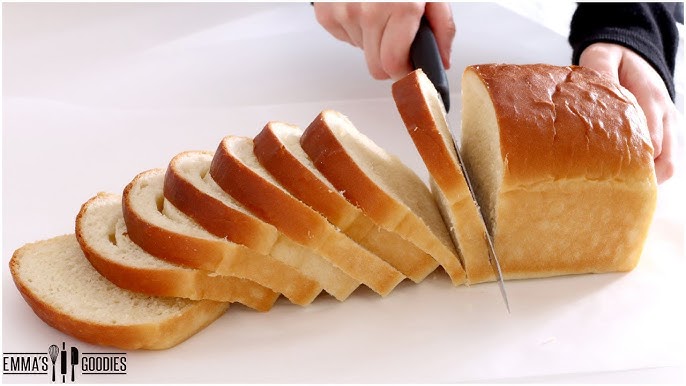Homemade Bread Recipe: Baking bread at home is a timeless tradition that fills your kitchen with warmth, the aroma of fresh dough, and the satisfaction of crafting something from scratch.
While it may seem intimidating at first, baking homemade bread is a rewarding process that anyone can master.
Let’s dive into this simple yet transformative recipe that will help you create the perfect loaf.
Ingredients for Homemade Bread
Basic Ingredients Required
To make a basic loaf of bread, you’ll need:
- Flour (All-purpose or bread flour works best)
- Water (Lukewarm, about 110°F/43°C)
- Yeast (Active dry or instant)
- Salt (For flavor)
- Sugar (Optional, helps yeast activate and adds a slight sweetness)
Optional Add-Ins for Extra Flavor
- Butter or Olive Oil (Adds moisture and richness)
- Herbs and Spices (Garlic, rosemary, or thyme for a savory twist)
- Seeds (Sunflower, sesame, or poppy for added crunch)
- Sweeteners (Honey, molasses, or maple syrup for a sweeter loaf)
Essential Tools and Equipment
Must-Have Tools for Bread Baking
- Mixing Bowls: A large bowl for mixing and proofing.
- Measuring Cups and Spoons: Precision is key for bread baking.
- Wooden Spoon or Silicone Spatula: For mixing ingredients.
- Baking Pan: Loaf pans or a baking sheet, depending on your bread type.
- Clean Kitchen Towel or Plastic Wrap: To cover the dough during proofing.
Optional Gadgets to Make Baking Easier
- Stand Mixer with Dough Hook: Reduces manual labor for kneading.
- Bench Scraper: Handy for shaping dough and cleaning your surface.
- Digital Scale: Ensures exact measurements for perfect results.
- Proofing Basket: For a professional look with artisan bread.
Preparing Your Workspace
Cleaning and Organizing
Before you begin, clear your counter and sanitize it. A clean workspace minimizes contamination and gives you ample space to work.
Creating the Right Environment for Bread Baking
Bread dough loves warmth. If your kitchen is cold, preheat your oven for a few minutes, then turn it off and let the dough proof inside. Avoid drafts or sudden temperature changes.
Step-by-Step Instructions
1. Activating the Yeast
Yeast is the magic ingredient that makes your bread rise. For active dry yeast:
- Mix 1 tablespoon of yeast with 1 cup of lukewarm water and a teaspoon of sugar.
- Let it sit for 5–10 minutes. It should foam up, signaling the yeast is active.
For instant yeast, you can skip the activation step and mix it directly with your dry ingredients.
2. Mixing the Dough
Combine your activated yeast, 3 cups of flour, 1 teaspoon of salt, and 1–2 tablespoons of sugar in a mixing bowl. Gradually add lukewarm water or milk until the dough comes together. Mix until there are no dry patches.
3. Kneading the Dough
Kneading develops the gluten, giving your bread its chewy texture. Turn the dough onto a floured surface and knead for 8–10 minutes. The dough should become smooth and elastic.
4. Letting the Dough Rise
Once your dough is kneaded to perfection, it’s time to let it rise, a process called proofing. Here’s how to do it:
- Lightly oil a large bowl to prevent sticking, and place your dough inside.
- Cover the bowl with a clean kitchen towel or plastic wrap to trap moisture.
- Let the dough rise in a warm, draft-free area for 1–2 hours or until it doubles in size.
- To check if it’s ready, press your finger gently into the dough. If it springs back slowly, it’s perfect for the next step.
Pro Tip: If your kitchen is cold, create a warm proofing environment by placing the bowl inside a slightly warmed (but off) oven or microwave with a cup of hot water beside it.
5. Shaping the Dough
Now comes the fun part—shaping your dough. This step determines the appearance and final texture of your bread.
- Gently punch down the dough to release trapped air bubbles.
- Turn it out onto a lightly floured surface and divide it into portions if making multiple loaves.
- Shape the dough according to your preference:
- For a classic loaf, roll the dough into a rectangle and fold it tightly into a log.
- For artisan-style bread, form a round boule or oval batard.
- Place the shaped dough onto a greased or parchment-lined baking pan.
Baking the Bread
1. Choosing the Right Temperature
The ideal baking temperature depends on the type of bread you’re making:
- For soft sandwich bread: Bake at 375°F (190°C) for 25–30 minutes.
- For crusty artisan bread: Bake at 450°F (232°C) for 30–40 minutes.
Always preheat your oven for at least 15 minutes before baking to ensure consistent results.
2. Using Steam for a Perfect Crust
Steam is the secret to a golden, crackling crust. To create steam:
- Place a small metal pan or baking dish on the bottom rack of the oven while it preheats.
- Add a cup of hot water to the pan just before placing the bread in the oven.
This step keeps the dough moist in the initial stages of baking, allowing it to expand and form a beautiful crust.
3. Checking for Doneness
To know if your bread is fully baked:
- Visual Check: The crust should be golden brown.
- Tap Test: Tap the bottom of the loaf—if it sounds hollow, it’s done.
- Thermometer Method: Insert a digital thermometer into the center of the bread. It should read 190°F (88°C) for soft bread and 200–210°F (93–99°C) for crusty bread.
Cooling and Storing Your Bread
1. Proper Cooling Techniques
Once out of the oven, resist the temptation to cut into your bread immediately. Place it on a wire rack to cool completely. Cutting too soon can result in a gummy texture as the steam hasn’t fully settled.
2. Storage Tips for Maximum Freshness
- Room Temperature: Wrap your bread in a clean kitchen towel or store it in a bread box. It will stay fresh for 2–3 days.
- Freezing: Wrap the bread tightly in plastic wrap, then aluminum foil, and store it in the freezer for up to 3 months. Thaw at room temperature when needed.
Troubleshooting Common Issues
1. Why Didn’t My Bread Rise?
- Check the freshness of your yeast. Expired yeast won’t activate.
- The water temperature might have been too hot or too cold.
- The dough was placed in a drafty or cold environment.
2. How to Fix Overbaked or Underbaked Bread
- For overbaked bread, brush the crust with butter to soften it.
- For underbaked bread, return it to the oven at a lower temperature (300°F/150°C) for 5–10 minutes.
3. Tips for Improving Texture and Flavor
- Use bread flour for a chewier texture.
- Incorporate a pre-ferment or sourdough starter for deeper flavor.
Variations and Enhancements
1. Adding Seeds, Herbs, and Spices
Experiment with flavors by mixing in ingredients like:
- Seeds: Chia, flax, or sunflower seeds for texture.
- Herbs: Dried rosemary, thyme, or oregano for a savory loaf.
- Spices: Cinnamon or nutmeg for sweet bread.
2. Making Whole Wheat or Gluten-Free Bread
For healthier options:
- Substitute part of the all-purpose flour with whole wheat flour. Add a little more water as whole wheat absorbs more moisture.
- For gluten-free bread, use a blend of gluten-free flours and add xanthan gum to mimic gluten’s elasticity.
Serving Suggestions
1. Pairing Bread with Meals
- Fresh bread is perfect with soups, stews, or pasta dishes.
- For breakfast, toast slices and top with butter, jam, or avocado.
2. Creative Ideas for Leftover Bread
- Make croutons by cubing and toasting with olive oil and seasoning.
- Use stale bread for bread pudding, French toast, or stuffing.
FAQs about Homemade Bread Recipe
1. What ingredients are needed for homemade bread?
To make homemade bread, you typically need all-purpose or bread flour, yeast, sugar, salt, warm water, and sometimes oil or butter. Optional ingredients like eggs, milk, or herbs can enhance flavor and texture.
2. How long does it take to make homemade bread?
Homemade bread takes about 2-3 hours, including preparation, rising, and baking time. The process can vary depending on the recipe and room temperature.
3. Can I make bread without a stand mixer?
Yes! Bread can be made by hand with simple tools like a bowl and wooden spoon. Kneading by hand takes about 8-10 minutes.
4. How do I know if my dough has risen enough?
The dough should double in size during the rising process. To test, gently press a finger into the dough; if the indentation remains, it’s ready.
5. What is the best way to store homemade bread?
Store homemade bread in a bread box, airtight container, or plastic bag at room temperature. For longer storage, freeze it in slices or whole loaves.
6. Can I use whole wheat flour instead of white flour?
Yes, but whole wheat flour may make the bread denser. You can mix it with white flour for a lighter texture.
7. What are common mistakes when making homemade bread?
Common mistakes include using water that’s too hot (kills yeast), under-kneading, or over-baking. Follow the recipe closely for the best results.
8. How can I add flavors to my bread?
You can add spices, herbs, cheese, nuts, or seeds to customize your bread. Mix them in during the kneading stage for even distribution.
Final Thoughts
Baking homemade bread is as much an art as it is a science. It takes practice, patience, and a bit of love to master. But with each loaf, you’ll find yourself growing more confident and creative. The process is deeply rewarding, and the results are far more satisfying than anything you can buy in a store. So, tie on your apron, roll up your sleeves, and start baking!



